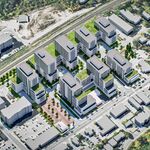Pro- or anti-suburbs has nothing to do with it: what you are is a moron for failing to appreciate the many degrees of pedestrian friendliness between a 400-series highway and Queen Street.
edit - other people, including myself, take issue, in a thread questioning stereotypes, with places being deemed only either pedestrian friendly or unfriendly instead of existing on a continuum derived from a host of complex measurements. There's more to it than pre-war = friendly, post-war = unfriendly. There's more to it than "well, it looks unfriendly" or "it's unfriendly because I say so." Who gets to decide what's measured or the weight of various measurements? Yonge & Wellesley is undeniably pedestrian friendly, but the sidewalks are so narrow that people are constantly forced to step into traffic or walk on the road at the intersection. Is Bay & Wellesley more friendly because the sidewalks are metres wider and the intersection, frankly, less dangerous?
Downtown Toronto busy intersections are typically very non-pedestrian friendly. Congested narrow sidewalks and intersections are typical of downtown. Yonge/Wellesley is not pedestrian friendly. The fact you say people basically spill onto the street proves it. Although Yonge/Charles St is arguably worse. People not only spill onto it, but the intersection always gives drivers and predestrians confusion as the intersection has a weird angle to it. Another non-friendly street for pedestrians.
Just because there's lots of people, just means there's lots of people living there, working there or shopping. Also, there's tons of students nearby.
Typical Yonge intersections are actually not pedestrian friendly.
- Most do not have advance crosswalk signals for walkers
- No bike lanes. Actually, aside from bike couriers you almost never see people riding bikes or rollerblading anywhere downtown unless they force themselves to go to Lakeshore or they want to do it at 11 pm at night. Too congested and unsafe to do it on the sidewalk or roads during normal hours.
- Narrow sidewalks
- No curbside grass or anything like that for buffer space
- Many downtown intersections do not even have corners paved smooth to allow people pushing strollers or wheelchair bound people to get up it
- Many busy streets have no bus service due to congestion unless its before or after rush hour. Since downtowners don't like driving, you are forced to walk, take streetcar or subway assuming your street has access to it and is close enough to where you want to go
- Way too many small short blocks, therefore there's tons of intersections and car traffic where pedestrians have to watch where they're walking or riding
- The fact there are so many taxis everywhere means people prefer not to walk or take transit
Reading this thread is basically suburban vs. urban or Mississauga vs. Toronto. As I said in an earlier post, there are pros and cons to both. For any anti-Mississauga people, you have to remember that most parts of Toronto are residential and suburban like Mississauga or Brampton anyway.
Painting all of Toronto like party core King St is a farce.





